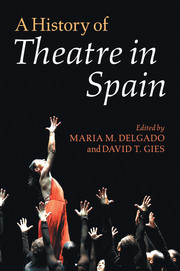Book contents
- Frontmatter
- Contents
- Illustrations
- Contributors
- Acknowledgements
- Introduction
- 1 The challenges of historiography
- 2 Lope de Vega, Calderón de la Barca and Tirso de Molina
- 3 The world as a stage
- 4 Playing the palace
- 5 The art of the actor, 1565–1833
- 6 Theatrical infrastructures, dramatic production and performance, 1700–1759
- 7 Popular theatre and the Spanish stage, 1737–1798
- 8 Theatre of the elites, neoclassicism and the Enlightenment, 1750–1808
- 9 Actors and agency in the modern era, 1801–2010
- 10 Zarzuela
- 11 Nineteenth-century Spanish theatre
- 12 Copyright, buildings, spaces and the nineteenth-century stage
- 13 Modernism and the avant-garde in fin-de-siècle Barcelona and Madrid
- 14 Continuity and innovation in Spanish theatre, 1900–1936
- 15 Theatrical activities during the Spanish Civil War, 1936–1939
- 16 Theatre, colonialism, exile and the Americas
- 17 Theatre under Franco (1939–1975)
- 18 Flamenco
- 19 Nationalism, identity and the theatre across the Spanish state in the democratic era, 1975–2010
- 20 Directors and the Spanish stage, 1823–2010
- 21 This evolution is still ongoing
- 22 Theatre as a process of discovery
- 23 Theatre is the art of the future
- Select bibliography
- Index
- References
2 - Lope de Vega, Calderón de la Barca and Tirso de Molina
Spain's Golden Age drama and its legacy
Published online by Cambridge University Press: 05 June 2012
- Frontmatter
- Contents
- Illustrations
- Contributors
- Acknowledgements
- Introduction
- 1 The challenges of historiography
- 2 Lope de Vega, Calderón de la Barca and Tirso de Molina
- 3 The world as a stage
- 4 Playing the palace
- 5 The art of the actor, 1565–1833
- 6 Theatrical infrastructures, dramatic production and performance, 1700–1759
- 7 Popular theatre and the Spanish stage, 1737–1798
- 8 Theatre of the elites, neoclassicism and the Enlightenment, 1750–1808
- 9 Actors and agency in the modern era, 1801–2010
- 10 Zarzuela
- 11 Nineteenth-century Spanish theatre
- 12 Copyright, buildings, spaces and the nineteenth-century stage
- 13 Modernism and the avant-garde in fin-de-siècle Barcelona and Madrid
- 14 Continuity and innovation in Spanish theatre, 1900–1936
- 15 Theatrical activities during the Spanish Civil War, 1936–1939
- 16 Theatre, colonialism, exile and the Americas
- 17 Theatre under Franco (1939–1975)
- 18 Flamenco
- 19 Nationalism, identity and the theatre across the Spanish state in the democratic era, 1975–2010
- 20 Directors and the Spanish stage, 1823–2010
- 21 This evolution is still ongoing
- 22 Theatre as a process of discovery
- 23 Theatre is the art of the future
- Select bibliography
- Index
- References
Summary
Lope Félix de Vega Carpio: establishing the norms
The most important dramatist of the Spanish Golden Age, Lope Félix de Vega Carpio (1562–1635), was a more impulsive and less reflective figure than his contemporary, Miguel de Cervantes (1547–1616), frustrated playwright and inventor of the novel. We know from the papers of his trial for libel in the late 1580s that Lope spent time in the theatre as an audience member, but he does not dwell in his writing on his own experience as a spectator. Cervantes, on the other hand, provides, in the prologue to the collection of plays and entremeses (interludes) he had published in 1615, quite a detailed account, tinged perhaps with a distorting nostalgia, of watching, as a youth, a play performed in a town square by the troupe of the famous Lope de Rueda (c. 1510–65). The rough and ready theatre was set up with:
cuatro bancos en cuadro y cuatro o seis tablas encima, con lo que se levantaba del suelo cuatro palmos . . . El adorno del teatro era una manta vieja, tirada con dos cordeles de una parte a otra, que hacía lo que llaman vestuario, detrás del cual estaban los músicos, cantando sin guitarra algún romance antiguo.
(four benches put in a square and four or six boards placed across them, all this raised just a couple of feet from the ground . . . The stage's decoration was an old blanket, pulled with two ropes from one side to the other, and which formed what they call a tiring room, behind which were the musicians, singing some ancient ballad without the accompaniment of a guitar.)
- Type
- Chapter
- Information
- A History of Theatre in Spain , pp. 36 - 56Publisher: Cambridge University PressPrint publication year: 2012



